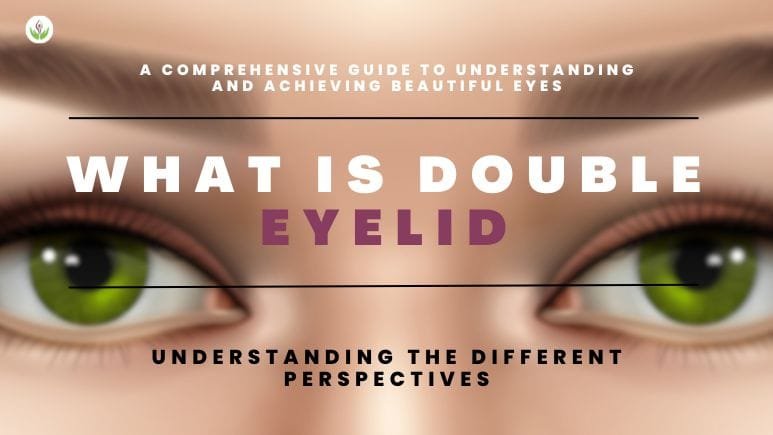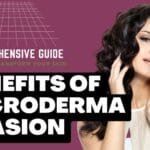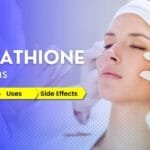Double eyelids have become a popular topic in the realm of beauty and cosmetic procedures. Many individuals seek to enhance their eye appearance by acquiring this specific eyelid feature.
In this article, we will delve into the concept of double eyelids, exploring its definition, surgical and non-surgical methods to achieve it, cultural significance, as well as its benefits and risks.
Understanding their importance and uncovering their cultural significance Double eyelids, also known as double eyelid folds or creases, are a unique characteristic of the upper eyelid that adds depth and dimension to the eyes.
They have captivated the attention of people across different cultures and have become a symbol of beauty and allure. Join us on this comprehensive journey as we explore the intricacies of double eyelids and their impact on society. So, let’s embark on a journey to discover the fascinating world of double eyelids.
Introduction
The eyes are considered windows to the soul, and their aesthetics play a significant role in facial attractiveness. Double eyelids, also known as “double eyelid folds” or “double eyelid creases,” refer to an eyelid feature where a visible crease appears when the eyes are open. This feature creates a defined fold on the upper eyelid, enhancing the appearance of the eyes.
Definition of Double Eyelids
Double eyelids can be defined as having a natural or surgically created crease on the upper eyelid that differentiates it from a monolid, where there is no visible fold. The presence of double eyelids adds depth and dimension to the eyes, making them appear larger and more expressive.
Understanding Eyelid Anatomy
The anatomy of the eyelid plays a crucial role in understanding the differences between single and double eyelids. To better comprehend the concept of double eyelids, it is essential to familiarize oneself with the underlying anatomical structures involved. The eyelids consist of several layers, including skin, muscle, and fat, all of which play a role in determining one’s eye shape and appearance. The presence or absence of a crease in the upper eyelid is primarily influenced by the attachment and arrangement of the levator muscle, which lifts the eyelid.
A. Structure of the Eyelid
The eyelid is composed of several layers and structures that contribute to its function and appearance:
- Skin: The outermost layer of the eyelid, providing protection and covering the underlying structures.
- Orbicularis Oculi Muscle: A circular muscle responsible for eyelid closure and blinking.
- Tarsal Plate: A dense connective tissue structure that provides structural support to the eyelid
- Meibomian Glands: Tiny oil-producing glands located within the tarsal plate, helping to lubricate the eye.
- Conjunctiva: A thin, transparent mucous membrane that covers the inner surface of the eyelid and the white part of the eye.
- Levator Palpebrae Superioris Muscle: The muscle responsible for elevating the upper eyelid.
B. Differences between Single and Double Eyelids
The key distinction between single and double eyelids lies in the presence or absence of a crease that separates the eyelid into distinct segments.
- Single Eyelid (Monolid):
- Characterized by a smooth eyelid without a visible crease.
- Common among East Asian, Southeast Asian, and some African ethnicities.
- Gives a unique appearance and is often associated with almond-shaped eyes.
- Double Eyelid:
- Exhibits a visible crease that divides the eyelid into two segments.
- Found in a variety of ethnicities worldwide, including Caucasians, some East Asians, and individuals with mixed heritage.
- Provides a distinct contour and enhances the definition of the eyelid.
Understanding the anatomical differences between single and double eyelids helps shed light on the factors that contribute to the variations in appearance and the potential for cosmetic alterations.
Genetic and Ethnic Factors
Genetic Inheritance of Eyelid Types
- Understanding the role of genetics in determining eyelid types
- Inheritance patterns and genetic markers related to double eyelids
- Genetic variations and their impact on eyelid structures
Prevalence in Different Ethnic Groups
- Examining the prevalence of double eyelids in various ethnicities
- Cultural and geographical influences on eyelid types
- Comparative studies on the occurrence of double eyelids across different population
Environmental and Lifestyle Factors
- Exploring the interplay between genetics and environmental factors
- Influence of lifestyle choices on the Development of double eyelids
- Environmental factors impact the expression of eyelid traits
Evolutionary Perspectives
- Evolutionary theories behind the development of different eyelid types
- Adaptive advantages or disadvantages associated with double eyelids
- Anthropological research on the evolution of eyelid structures
Genetic Modification and its Implications
- Ethical considerations related to genetic modification of eyelid traits
- Potential risks and benefits of altering eyelid types through genetic engineering
- Societal and cultural perspectives on the genetic modification for aesthetic purposes
Intersections of Genetics and Identity
- Influence of eyelid types on Self-identity and cultural belonging
- The Significance of eyelid traits in Personal and collective identities
- Empowering individuals with diverse eyelid types to embrace their uniqueness
Genetic Counseling and Education
- Providing genetic counseling services related to eyelid traits
- Educating individuals and families about genetic inheritance and diversity
- Addressing misconceptions and promoting accurate information about genetic factors in eyelid types
Cultural Perceptions and Beauty Standards
Historical and Cultural Perspectives on Double Eyelids
- Double eyelids have a rich history in various cultures.
- Ancient texts and artworks depict the admiration of double eyelids.
- Examples of historical figures who were celebrated for their double eyelids.
Influence on Beauty Ideals in Various Cultures
- East Asian Beauty Standards:
- The association of double eyelids with beauty and femininity.
- Influence on beauty pageants, media, and entertainment industries.
- The rise of double eyelid surgery as a popular cosmetic procedure.
- Western Beauty Standards:
- Western perceptions of double eyelids and their impact on beauty standards.
- The cultural exchange and adoption of certain features, including double eyelids.
- The role of social media and influencers in promoting double eyelids as an aesthetic ideal.
- South Asian Beauty Standards:
- Cultural diversity in South Asia and varying perceptions of double eyelids.
- The influence of Bollywood and regional film industries on beauty ideals.
- Traditional practices and makeup techniques emphasize the appearance of double eyelids.
- African Beauty Standards:
- Embracing natural features and challenging Westernized beauty standards.
- The appreciation of diverse eyelid shapes and sizes.
- Contemporary discussions on cultural exchange and double eyelids.
- Indigenous Beauty Standards:
- The importance of indigenous beauty standards and self-acceptance.
- Respecting and preserving traditional features and aesthetics.
- Empowering narratives of embracing unique eyelid characteristics.
- Global Beauty Standards:
- The globalization of beauty standards and their impact on double eyelids.
- The role of cultural appreciation versus cultural appropriation.
- Encouraging inclusivity and celebrating diverse beauty ideals.
Note: The headings and subheadings provided above aim to outline the content and structure of the article. The actual article will contain detailed information and explanations under each heading, with proper references and sources where necessary.
Types of Double Eyelids
There are two primary types of double eyelids: natural and surgically created.
- Natural Double Eyelids: Some individuals are born with natural double eyelids, where the crease is naturally present when their eyes are open. This feature is more common among people of Asian descent but can be found in other ethnicities as well.
- Surgically Created Double Eyelids: Double eyelid surgery, also known as blepharoplasty, is a cosmetic procedure that creates a crease on the upper eyelid. People who want double eyelids but were not naturally born with them frequently seek out this surgical procedure.
Double Eyelid Surgery
Reasons for Double Eyelid Surgery
People opt for double eyelid surgery for various reasons. Some of the common motivations include:
- Enhancing the appearance of the eyes: Double eyelid surgery can make the eyes appear larger, brighter, and more aesthetically pleasing.
- Boosting self-confidence: Individuals who feel self-conscious about their monolids may choose this procedure to improve their overall self-image and confidence.
- Aligning with cultural beauty standards: In certain cultures, double eyelids are considered a beauty ideal, and individuals may undergo surgery to conform to these standards.
Procedure and Techniques
Double eyelid surgery involves the creation of a fold on the upper eyelid to simulate the appearance of natural double eyelids. The procedure is typically performed under local anesthesia and can be carried out using different techniques:
- Full Incision Method: This technique involves making an incision along the upper eyelid, removing excess skin, and creating a new crease. It is suitable for individuals with excess skin or fat deposits in the eyelid area.
- Partial Incision Method: In this technique, a partial incision is made to remove excess tissue and create a crease. It is commonly used for individuals with minimal excess skin.
- Suture Method: Also known as the non-incisional method, this technique involves creating double eyelids by strategically placing sutures along the eyelid to form a crease. It is a less invasive option with a shorter recovery time.
Natural Double Eyelids vs. Surgical Options
Natural Double Eyelids
Natural double eyelids are those that occur without any external intervention. They are typically inherited and can be found in various ethnicities, including East Asians, Southeast Asians, and some individuals of African descent. Genetics and the underlying anatomical factors mentioned previously determine the presence of a natural double eyelid crease.
Surgical Options
For individuals who desire double eyelids but do not have them naturally, there are surgical options available to create the desired aesthetic. Two common procedures are:
- Double Eyelid Surgery (Blepharoplasty): This surgical procedure involves creating an upper eyelid crease through the removal or alteration of excess skin, muscle, or fat. It is a customizable procedure that can be tailored to suit individual preferences and desired outcomes.
- Non-Invasive Techniques: Various non-surgical techniques have emerged as alternatives to traditional surgery. These techniques include the use of specialized tapes or adhesives to create a temporary double eyelid fold. While these options provide a non-permanent solution, they can be useful for individuals who prefer non-invasive methods or want to test the appearance of double eyelids before committing to surgery.
Recovery and Aftercare
Following double eyelid surgery, proper recovery and aftercare are crucial. The initial recovery period may involve swelling, bruising, and discomfort, which can be managed with prescribed medications and cold compresses. It is essential to follow the surgeon’s instructions regarding post-operative care, including keeping the surgical area clean, avoiding strenuous activities, and attending follow-up appointments.
Benefits and Risks of Double Eyelid Surgery
Benefits of Double Eyelid Surgery
- Enhanced eye appearance: Double eyelid surgery can create a more defined and attractive eye contour.
- Increased self-esteem: For individuals who feel insecure about their monolids, the surgery can provide a significant boost in self-confidence.
- Versatile makeup options: With double eyelids, applying eye makeup becomes easier, and individuals can experiment with various styles and techniques.
Potential Risks and Complications
While double eyelid surgery is generally safe, there are potential risks and complications associated with the procedure. These may include:
- Swelling and bruising: Temporary swelling and bruising are common after surgery but usually subside within a few weeks.
- Infection: In rare cases, an infection may occur, requiring medical intervention.
- Scarring: Depending on the surgical technique used, there may be minimal scarring, which usually fades over time.
- Unsatisfactory results: In some instances, the desired outcome may not be achieved, and revision surgery might be necessary.
Read More: Is Eyelid Lifting (Blepharoplasty) Procedure Safe in 2022?
Non-Surgical Methods to Create Double Eyelids
Apart from surgical options, there are non-surgical methods available for individuals who wish to create the illusion of double eyelids without undergoing surgery. Some popular techniques include:
- Makeup Techniques: Using eyeshadow, eyeliner, and mascara, individuals can create the appearance of a double eyelid fold through contouring and shading.
- Eyelid Tape and Glue: Specialized eyelid tapes and glues can be used to temporarily adhere to the eyelid skin, creating a natural-looking crease.
- Eyelid Trainer Devices: These devices are designed to train the eyelids to develop a natural crease over time by exerting gentle pressure on the eyelid area.
Factors to Consider Before Pursuing Double Eyelid Enhancement
Before deciding to undergo any form of double eyelid enhancement, it is crucial to consider several factors, including:
- Personal Motivation: Understanding your personal motivations for pursuing double eyelid enhancement is essential. It is important to ensure that your decision aligns with your own desires and aspirations, rather than societal pressure or external influences.
- Realistic Expectations: It is crucial to have realistic expectations regarding the outcome of any double eyelid procedure. Consulting with a qualified professional will provide you with a clearer understanding of what can be achieved based on your individual eye anatomy.
- Risks and Complications: As with any surgical or non-surgical procedure, there are inherent risks and potential complications involved. It is important to discuss these with a medical professional and make an informed decision based on your specific circumstances.
- Recovery and Downtime: Double eyelid surgery typically involves a recovery period, during which swelling and bruising may occur. Understanding the recovery process and allowing ample time for healing is essential for a successful outcome.
Choosing the Right Surgeon or Practitioner
When considering double eyelid enhancement, selecting a qualified and experienced surgeon or practitioner is of utmost importance. Here are some key points to consider during the selection process:
- Credentials and Qualifications: Ensure that the surgeon or practitioner you choose is certified and has the necessary qualifications to perform double eyelid surgery or provide other enhancement options. Look for credentials such as board certification and membership in relevant professional organizations.
- Experience and Expertise: Research the surgeon’s or practitioner’s experience in performing double eyelid procedures. Look for before-and-after photos, patient testimonials, and reviews to gain insights into their skills and results.
- Consultation Process: A thorough consultation is essential for discussing your goals, expectations, and any concerns you may have. During this process, the surgeon or practitioner should evaluate your eye anatomy, provide personalized recommendations, and answer any questions you may have.
- Communication and Comfort: It is crucial to choose a surgeon or practitioner with whom you feel comfortable communicating openly. Clear and effective communication is essential for a successful outcome and a positive overall experience.
Cultural Significance of Double Eyelids
Double Eyelids in Asian Cultures
In many Asian cultures, double eyelids have traditionally been associated with beauty and are often regarded as a desirable feature. The preference for double eyelids can be traced back to cultural influences, media representation, and societal beauty standards.
Western Perception and Influence
In recent years, double eyelids have gained popularity beyond Asian communities and have become sought-after globally. Double eyelids have evolved into a popular aesthetic choice for people of various ethnic backgrounds thanks to media, fashion trends, and the increasing diversity of beauty standards.
Conclusion
Double eyelids, whether natural or achieved through surgery, have become a significant aspect of facial aesthetics. Understanding the concept, surgical and non-surgical methods, as well as the cultural significance surrounding double eyelids, allows individuals to make informed choices regarding their eye appearance.
Whether one chooses to embrace their natural features or opt for cosmetic enhancements, the decision should be based on personal preferences and a thorough understanding of the benefits and potential risks involved. Remember, the journey to beautiful eyes begins with understanding and choosing the right path for you.














